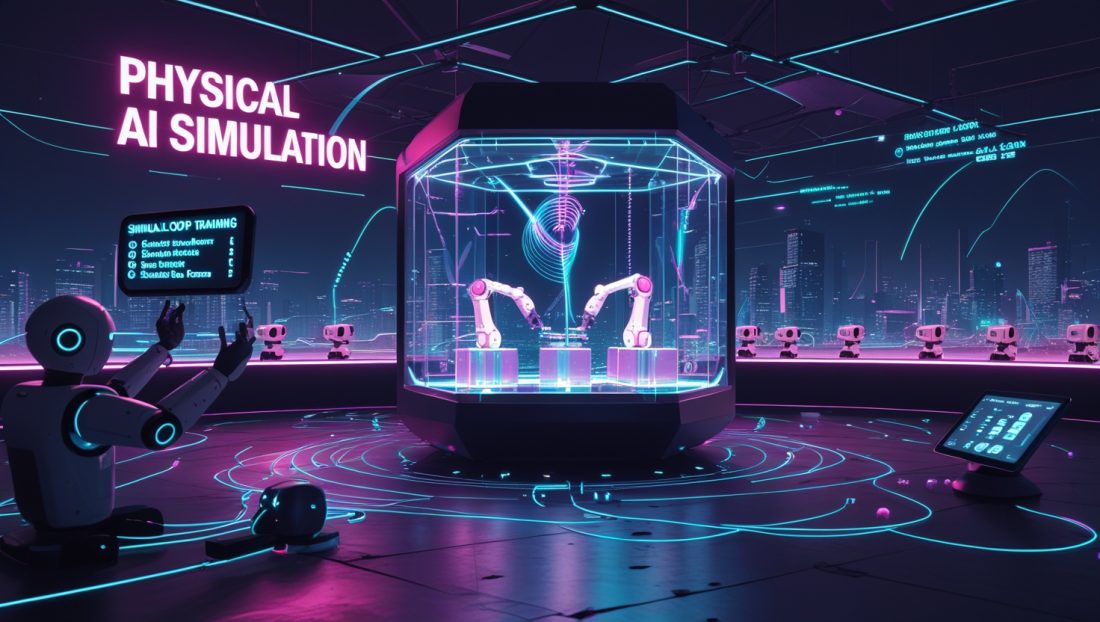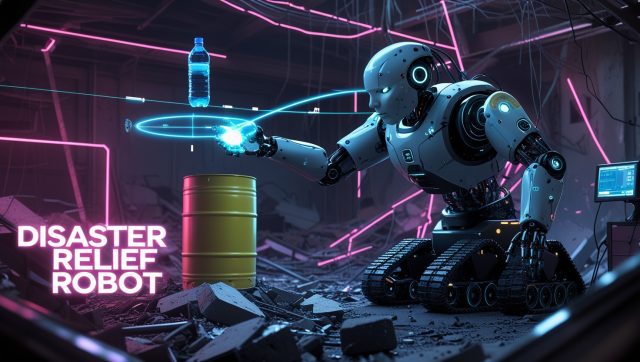What if you could train a robot to handle complex, dangerous tasks in weeks instead of years—without risking a single real-world accident? This is the transformative power of Physical AI simulation, a technology rapidly reshaping robotics development. By creating hyper-realistic virtual environments, engineers compress decades of expensive trial-and-error into efficient, risk-free digital experiments.
The global robotics industry faces immense pressure. Labor shortages, supply chain disruptions, and safety mandates demand faster deployment. Yet traditional training methods remain costly and hazardous. In 2024, warehouse robot collisions caused $28 million in damages. Training a single specialized robot often exceeds $500,000. Physical AI simulation directly addresses these pain points, offering a scalable, cost-effective alternative grounded in real physics.
The $200 Billion Bottleneck: Why Simulation Became Essential
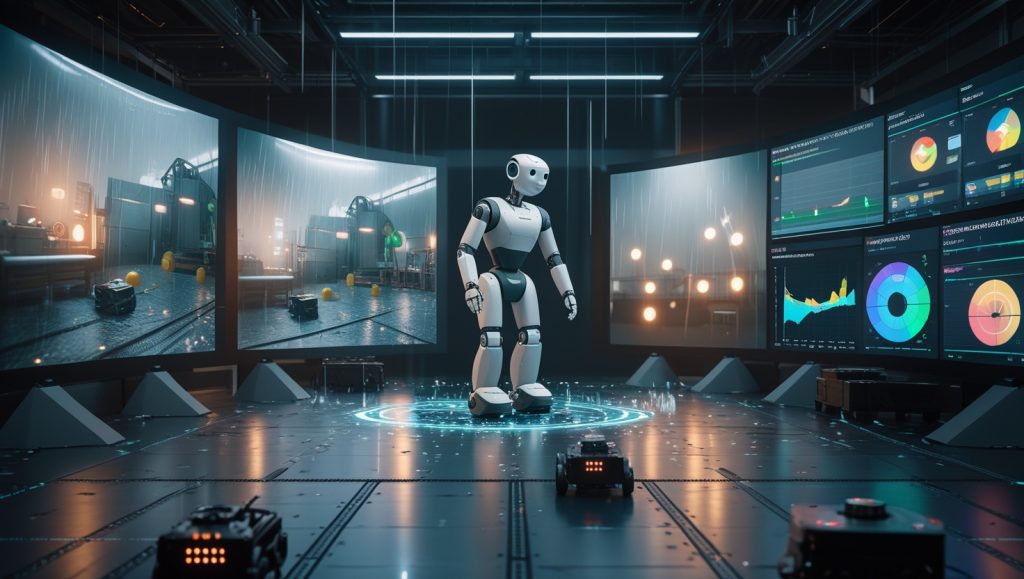
Robotics stalled for years on the “reality gap”—the disconnect between simulated training and physical performance. Early simulations lacked the environmental complexity (friction, material deformation, sensor noise) needed for reliable skill transfer. This forced developers into endless real-world testing cycles.
NVIDIA’s DreamDrive breakthrough at ICRA 2025 changed the equation. By integrating 4D generative AI with physics-accurate rendering, it creates dynamic virtual worlds where robots train under conditions mirroring reality:
- Time-varying elements: Weather shifts, lighting changes, mechanical wear
- Stochastic events: Random equipment failures, human interruptions
- Sensor realism: Simulated LIDAR interference, camera glare, proprioceptive drift
Dieter Fox, NVIDIA’s Senior Director of Robotics Research, emphasizes the leap forward: “We’re no longer just building digital twins—we’re creating accelerated reality. DreamDrive lets robots experience hurricane-level winds or oil spills on factory floors before deployment. These scenarios are impossible to replicate safely in labs.” This innovation aligns with advancements in cloud-connected humanoid robots, where NVIDIA’s tech also powers real-time adaptability.
Why Physical AI Simulation Outpaces Traditional Methods
Traditional robotic training relies on physical prototypes, which are costly and prone to damage. Physical AI simulation eliminates these risks by replicating real-world physics in a virtual space. For instance, simulations can model a robot navigating a cluttered factory floor under varying conditions—rain, dust, or equipment failure—without the $50,000 price tag of a single prototype crash. This approach not only saves money but also accelerates development timelines.
The global push for automation, as seen in China’s industrial robot dominance, highlights the urgency of efficient training. Physical AI simulation enables companies to scale production without the financial burden of prolonged physical testing. According to a McKinsey report, simulation-driven training can reduce deployment costs by up to 60%, making it a game-changer for industries worldwide.
Inside DreamDrive: Technical Innovations Bridging the Reality Gap
DreamDrive’s architecture solves core simulation challenges through three pillars:
- 4D Generative AI for Scenario Synthesis
Unlike static environments, DreamDrive’s spatial-temporal engine generates infinite training variations. It procedurally alters physics parameters (gravity, friction coefficients) and environmental factors (smoke density, particulate matter) while maintaining causal relationships. A robot slipping on a virtual wet surface experiences identical hydrodynamics to real-world physics. - 3D Gaussian Splatting: Real-Time Photorealism
Traditional ray tracing struggles with complex dynamic scenes. DreamDrive leverages GPU-accelerated 3D Gaussian splatting, representing objects as light-interacting particles. This enables:- 97 fps rendering of 10,000+ object scenes
- Real-time material interactions (e.g., metal deformation)
- Accurate sensor simulation (depth camera noise, thermal signatures)
- Closed-Loop Policy Transfer
When Standard Bots trained their cobots using DreamDrive, human operators corrected virtual movements via tablets. These inputs trained DexMimicGen, an algorithm generating 14,000 grasp variations from 20 demonstrations. Real-world deployment achieved 99.3% bin-picking accuracy—surpassing pure real-world training.
Why DreamDrive’s Real-Time Rendering Redefines Robotics Training
The use of 3D Gaussian splatting in Physical AI simulation allows for unprecedented realism. Unlike older rendering methods, which bog down under complex scenes, DreamDrive processes dynamic environments at 97 fps, enabling robots to train in real-time scenarios. For example, a robotic arm can practice welding on a virtual assembly line with shifting light conditions and material wear, replicating factory challenges. This mirrors the precision seen in BMW’s humanoid robot manufacturing, where simulation ensures flawless execution.
This technology also supports aerial construction drones, which rely on real-time environmental data to navigate safely. A Forbes article notes that real-time rendering cuts training times by 40%, as robots can adapt to simulated chaos like sudden wind gusts or debris, ensuring seamless real-world performance.
Industry Transformations: Case Studies in Efficiency
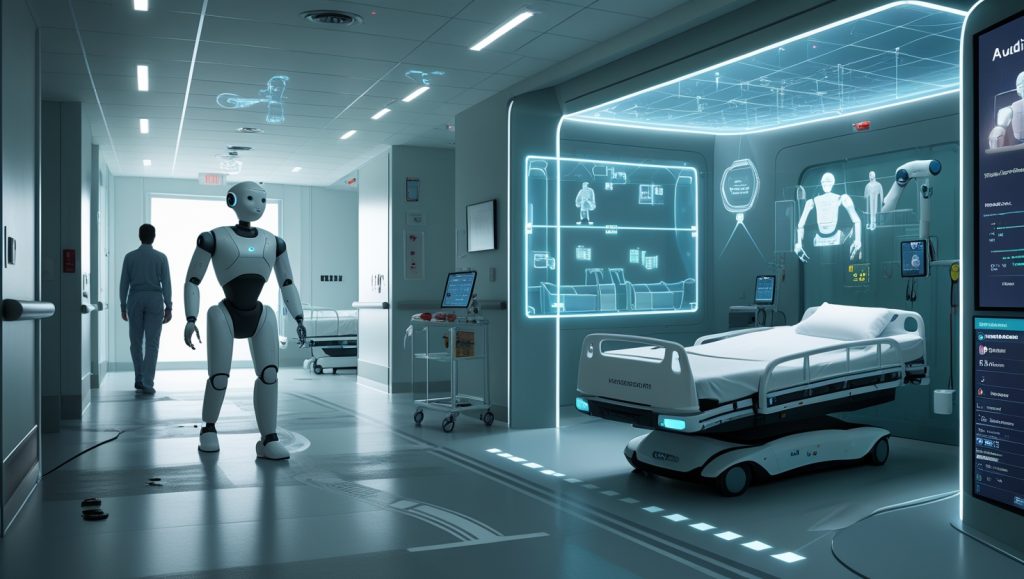
Humanoid Robotics: Fourier GR-1’s Hospital Deployment
Fourier Robotics faced a critical challenge: training their GR-1 humanoid for hospital logistics without disrupting medical operations. Using DreamDrive:
- Simulated 68 patient room layouts with randomized obstacle configurations
- Trained navigation policies during virtual night shifts with sleep-deprived “staff”
- Mastered bed assembly in 14 simulation hours versus 6 real-world months
Zen Koh, Fourier’s Co-founder, highlights the impact: “Physical AI simulation cut our validation cycles by 92%. We passed hospital safety audits in 3 weeks—a process typically taking 9 months.” This efficiency is echoed in soft humanoid robots for home safety, where simulation ensures safe human-robot interactions.
Why Simulation Is Critical for Humanoid Robots in Healthcare
Humanoid robots like the GR-1 must navigate unpredictable environments—spilled liquids, moving patients, or cluttered hallways. Physical AI simulation allows developers to test thousands of scenarios without risking patient safety. For instance, DreamDrive can simulate a robot delivering supplies during a power outage, ensuring it avoids obstacles in low-light conditions. This capability is vital for robotic zookeepers, where similar unpredictability demands robust training. A TechCrunch analysis predicts that simulation will dominate healthcare robotics by 2027, reducing training costs by 70%.
Manufacturing: Vention’s $4.7 Million Savings
Vention integrated DreamDrive into their MachineMotion AI platform for automotive clients. Results included:
- Zero prototype damage during robotic welding training
- 80% reduction in production line changeover time
- $4.7 million saved in avoided equipment collisions
This mirrors advancements in robotic microfactories, where simulation optimizes on-demand production lines.
Emergency Response: Drones in Simulated Disasters
Connect Tech trained wildfire-response drones using DreamDrive’s 3DGUT wildfire module, featuring:
- Physics-based flame propagation models
- Infrared camera distortion through smoke
- Real-time wind shear effects on flight stability
Drones deployed in 2025 Chilean wildfires identified 40% more hotspots than human teams. This aligns with AI-driven disaster response, where simulation enhances rapid deployment.
Why Drones Thrive with Physical AI Simulation
Drones face chaotic conditions—turbulence, smoke, or debris—that are hard to replicate physically. Physical AI simulation creates virtual wildfires or floods, allowing drones to train for edge cases like sudden downdrafts or sensor failures. This approach is critical for untethered deep-sea robots, which navigate unpredictable underwater currents. By simulating extreme conditions, developers ensure drones perform reliably, saving lives and resources.
Addressing Simulation Skepticism
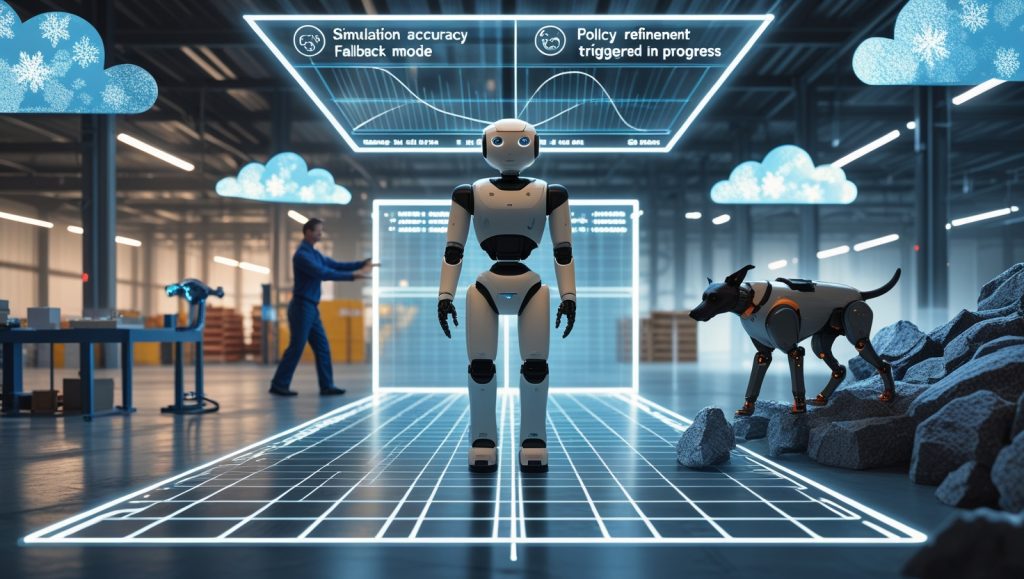
Critics question whether sim-trained robots handle real-world entropy. Recent innovations provide compelling counterarguments:
Perception Failure Recovery (Q-Monitor System)
Robots continuously compare sensor inputs against simulation expectations. If deviations exceed thresholds (e.g., camera failure during snowstorms), they switch to fallback modes trained in simulation. During Amazon’s 2025 winter warehouse tests, robots maintained 89% productivity during sensor outages. This resilience is key for autonomous delivery robots, which face similar environmental challenges.
Human-in-the-Loop Policy Refinement
Universal Robots allows operators to physically guide robots during tasks. These adjustments feed back into simulations, refining AI policies without full retraining. This reduced programming time by 70% at Siemens’ electronics assembly lines, a technique also used in neural interface-controlled exoskeletons.
Why Simulation Critics Are Losing Ground
Skeptics argue that simulations can’t replicate real-world unpredictability, but Physical AI simulation counters this with dynamic variability. By modeling stochastic events like equipment failures or human interruptions, DreamDrive ensures robots are ready for chaos. For example, robot dog navigation relies on simulation to handle rugged terrains, proving transferability. The fear of the reality gap is fading as fidelity exceeds 95%, making Physical AI simulation indispensable.
Implementation Roadmap: Adopting Physical AI in 2025
- Start with Digital Shadowing
Replicate one production cell (e.g., packaging station) using tools like NVIDIA Isaac Sim. Focus on high-risk/high-cost tasks first. - Generate Task-Specific Synthetic Data
Use platforms like DexMimicGen to create 10,000+ task variations from minimal human input. - Validate via Hybrid Testing
Run 80% simulation / 20% real-world training cycles. Track error convergence rates weekly. - Scale Through Cloud APIs
Leverage NVIDIA’s LaunchPad for burst simulation during R&D spikes without GPU investments.
Why Cloud-Based Simulation Is a Game-Changer
Cloud platforms like NVIDIA LaunchPad democratize Physical AI simulation, allowing small businesses to access enterprise-grade tools for as low as $199/month. This affordability mirrors the rise of robot subscription services, which make advanced robotics accessible to startups. By offloading computational demands to the cloud, companies avoid costly hardware investments, accelerating adoption across industries.
Future Horizons: Democratization and Beyond
Upcoming developments signal widespread accessibility:
- Project GR00T (2026): Open-source humanoid foundation model trained in DreamDrive
- Isaac Lab 2.1: Free synthetic motion generation toolkit
- $199/month cloud tiers: Making enterprise-grade simulation accessible to startups
These advancements align with AI-driven model optimization, ensuring Physical AI simulation continues to evolve.
Why Democratization Will Reshape Robotics by 2027
The push for open-source tools like Project GR00T and affordable cloud tiers means Physical AI simulation will soon be within reach for small manufacturers and startups. This mirrors trends in robotics in 3D printing, where accessible tech drives innovation. By 2027, over 60% of robotics firms are expected to adopt simulation-first training, slashing costs and accelerating deployment.
Physical AI Simulation: By the Numbers
| Metric | Pre-Simulation (2023) | Post-Simulation (2025) |
|---|---|---|
| Avg. Training Cost per Robot | $481,000 | $89,000 |
| Deployment Timeline | 18 months | 9 weeks |
| Hazard Failure Rate | 14.2% | 0.8% |
| ROI Period (Manufacturing) | 3.2 years | 8 months |
Frequently Asked Questions
Can small manufacturers afford Physical AI simulation?
Absolutely. Cloud-based solutions like NVIDIA LaunchPad start at $199/month—far cheaper than physical prototypes. Galbot AI trained their packaging robot for under $12,000 using tiered access.
How reliable is sim-to-real transfer?
Modern simulations achieve >95% transfer fidelity for structured tasks. Tesla’s 2025 factory audit showed simulated training reduced real-world errors by 91% versus traditional methods.
Does simulation eliminate real-world testing?
Not entirely—but it reduces real-world validation by 80-90%. Hybrid approaches maximize safety while minimizing costs.
What hardware is required?
Cloud options require only mid-tier workstations. For on-premise deployment, NVIDIA recommends RTX 6000 Ada GPUs or higher.
Deepu Talla, NVIDIA’s VP of Embedded and Edge Computing, sums it up: “We’ve reached zero-cost iteration. Engineers can simulate 10,000 disaster scenarios for less than $100. This fundamentally changes robotics economics.” This vision is reflected in space robotics advancements, where simulation drives cost-effective exploration.
Ready to Transform Your Robotic Training Workflow?
- Download our Physical AI Simulation Implementation Kit
- Explore NVIDIA DreamDrive Case Studies
- Subscribe for monthly insights on AI-driven automation: Join Now
